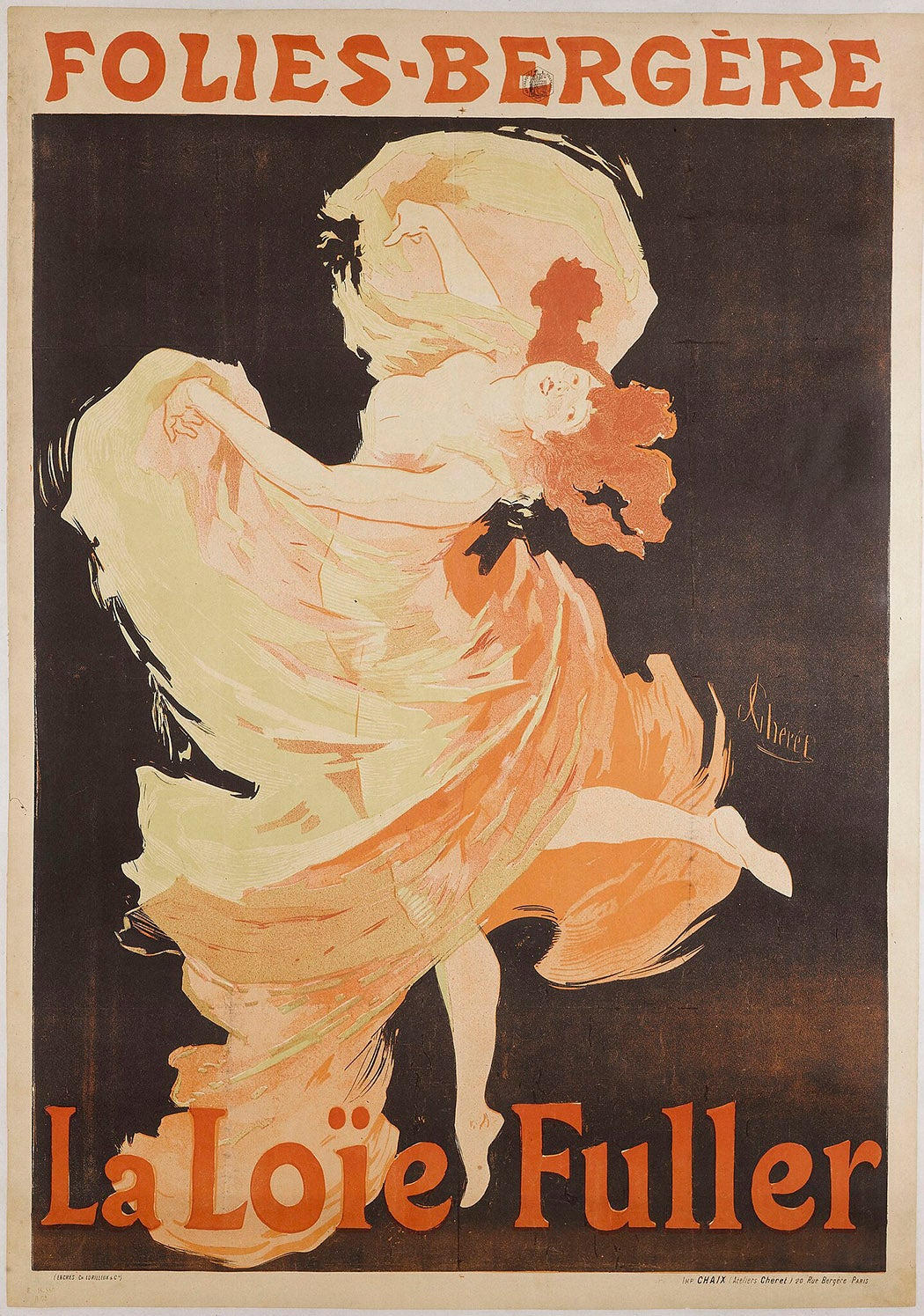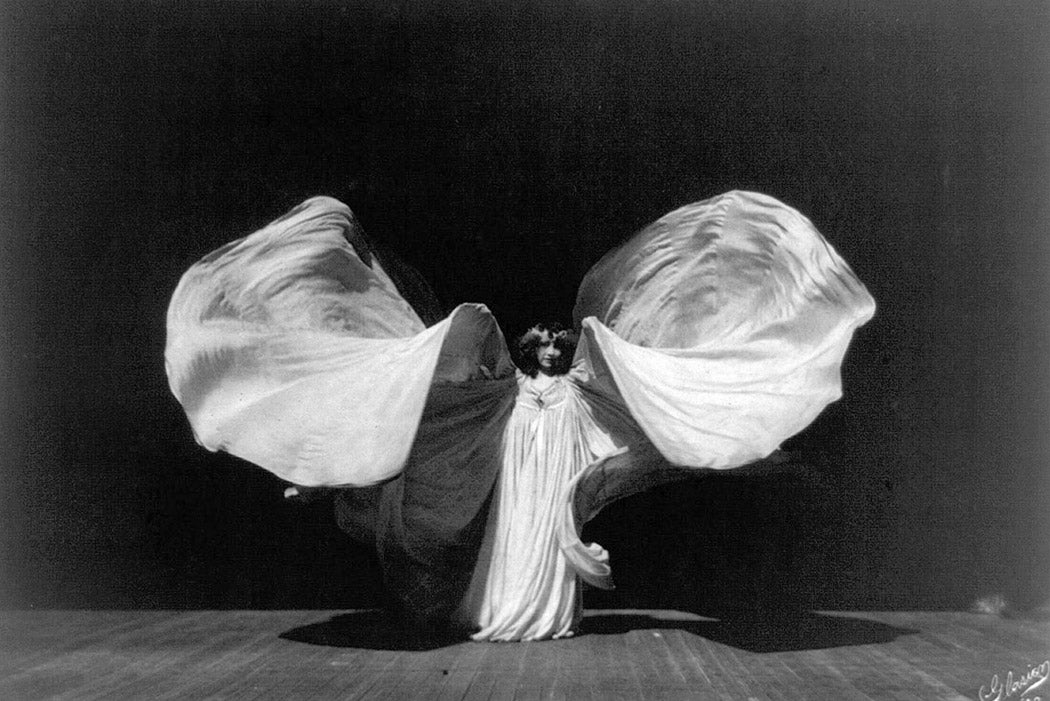No doubt you’ve heard the story before: a young woman with her eyes set on a career in entertainment makes her way to the big city, ready to pay her dues and become the next overnight success. (The trope is well-worn for a reason.) Initially, that would appear to be Loïe Fuller’s story, too. Born in farm country near Chicago in 1862, Fuller made her stage debut as a child, and by her teen years, she had progressed to roles in touring comedy and with Buffalo Bill’s Wild West show. She spent the better part of the next two decades as a jane-of-all-trades in the amusement industry, in turns an actress, playwright, and burlesque dancer.
In 1892, though, she hit on something new. As a specialty dancer in a play called Uncle Celestine, she introduced a dynamic, floating dance in which she tossed the folds of her voluminous dress into elaborate patterns and swirls while bathed in light. It would come to be known as the “Serpentine Dance.”
For the dance, Fuller took center stage in a tremendously oversized gown of light-colored silk, boned through with rods she controlled with her hands. As music played, she swung the rods in huge reaching arcs, creating ephemeral shapes that appeared to have analogs in nature—here a butterfly, there a cloud, there the waves of a choppy sea. As she danced, operators projected a sequence of colored lights onto the moving fabric. The overall effect was mesmerizing. Coming from popular theater, Fuller had taken “skirt dances,” which were popular at the time in vaudeville and burlesque. A typical skirt dance combined the audience’s taste for dance performance with its appetite for forbidden eroticism (the dances might involve young women doing gymnastic feats, fabric manipulation, or just the plain old “can-can”). Fuller stretched this more-established form into exaggerated territory, added her sense of dramaturgy, and embraced the innovative ideas of electric light.
A New York reviewer called her performance “unique, ethereal, delicious.,” writes scholar of early cinema Tom Gunning.
The Serpentine was clearly something new and dazzling, but Fuller had a hard time getting American audiences to see her as more than a low-art dancing girl. She decided to try her luck overseas and was booked after a single audition to appear at the famous Folies Bergère in late 1892. The move was a lucky one for her: where Americans had a hard time categorizing her work within high art, French artists and intellectuals navigating fin de siècle culture loved her.

Artists and critics within the Symbolist movement, especially, saw the Serpentine as a glorious rebellion against the onrush of modernity. Where technology and industry were hard and clinical, Fuller, with her fluid folds of silk, hearkened back to older ideas of experience, immersion, spirituality, and expansion. (Ironically, Fuller would use technology and modernity to create her impression of transcending it.) She was a tremendous critical and popular success.
“Even her name changed,” writes dance historian and critic Sallie R. Sommer, noting that where American papers called her “little Loïe Fuller,” she “became known to Paris as ‘La Loïe,’ signaling rather appropriately the change from Artistic to artist.”
According to Fuller biographer Margaret Haile Harris, the Symbolist poet Georges Rodenbach raved that Fuller “proved that woman can when she wants, become the Universe: she was a flower, a tree in the wind, a changing cloud, a giant butterfly, a garden with paths of pleated fabric.”
Fuller was a somewhat unlikely star. Scholar of French literature Rhonda K. Garelick notes that, in contrast to general expectations of dancers, Fuller was short and thickly built, neither especially lovely nor graceful, and generally seemed not to care much for her appearance. But this didn’t matter, because when Fuller stepped onto a stage, she effectively disappeared into the folds of swirling silk, powering her illusions from the inside with heft and vision.
Strong-willed, Fuller was a creative force with experimental ideas about dance and light. “Dance” itself was even a limiting descriptor. Sommer recalls that in a 1914 speech, Fuller claimed to be
less interested in choreographing a dance in which the steps were exactly bound to the rhythm than creating a unity where dancing bodies, lights, and silks captured musical phrases, giving a visual analog to the rush and flow of musical tones.
Bringing color, movement, sound, and narrative all together in a wordless performance, she made music visible.
Fuller worked constantly and quietly on the light devices and slides that projected color over her giant gowns, using glass, gelatines, and chemical tints to elicit increasingly fluid and complex effects. She received a United States patent on the design for a gown with curved, hand-held rods with which she manipulated what could be hundreds of yards of fabric. She was also granted membership in the French Astronomical Society “for her contributions to investigations about light.”
All was not sweetness and light, though. Fuller was broadly panned for her performances of Salome, which she gave at two different points in her career. Critics didn’t hesitate to express their unkindness toward her and her famously stout physique, writing that she was “a Salome for Yankee drunkards,” with “the grace of an English boxer and the physique of Oscar Wilde,” notes Harris. Audiences seemed to prefer Fuller as an operator and an auteur rather than as an actress who was incapable of disappearing into a character as she had been able to within her creations of grand, swirling forms of fabric.
Despite these failures, Fuller’s stardom was ensured, and it was based on artistry, technology, and philosophy, not any sense of glamor or sex appeal, unlike that of many other famous women in turn-of-the-century entertainment. Garelick points out that
journalists tended to describe her personal life as ‘chaste’ and ‘correct,’ writing often of her relationship with her mother and rarely even mentioning her live-in female companion of more than twenty years, Gabrielle Bloch, a Jewish-French banking heiress who dressed only in men’s suits.
In the end, Fuller’s greatest talent was syncretism and synthesis. She defied genre to create a new art form that not only combined prior elements but leveraged new technology and foreshadowed artistic areas like cinema (the film scholar Tom Gunning argues that Fuller, with her embrace of light, was a forerunner of cinematic thinking and art). In fact, she dreamed of creating a future “Temple of Light,” writes Sommer.
Weekly Newsletter
“I consider my work to to be the point of departure of the great light symphony,” Fuller once said, “which will transform the theater of the future. We don’t know enough about the infinite resources of light, and how many treasures are enclosed in the simple ray of a projector.”
In such an avant-garde Temple of Light, a venue of “of pure illusion and metamorphosis,” the audience would make “its own scenario of associations,” using its own creative thinking and imagination to bring meaning to Fuller’s performance.







